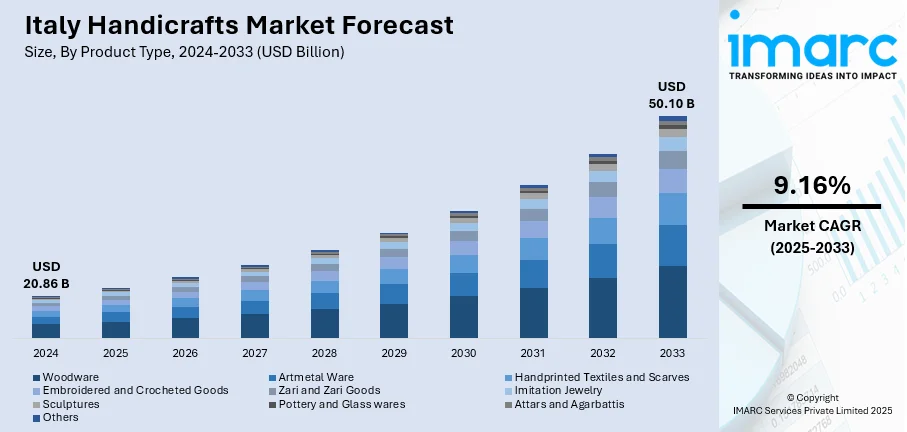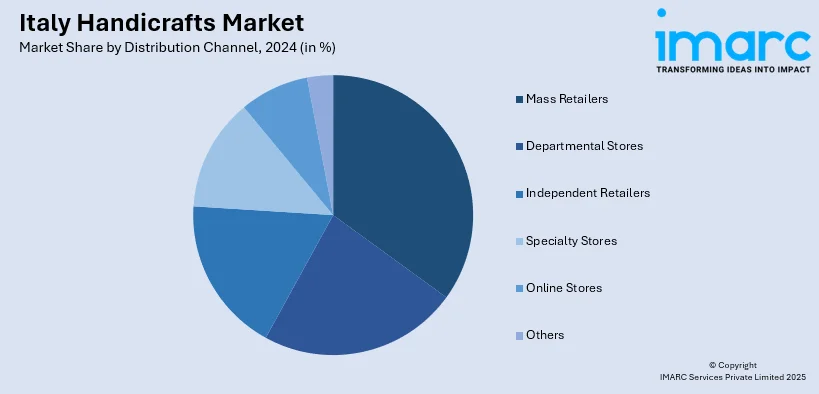
Italy Handicrafts Market Size, Share, Trends and Forecast by Product Type, Distribution Channel, End Use, and Region, 2025-2033
Italy Handicrafts Market Overview:
The Italy handicrafts market size reached USD 20.86 Billion in 2024. Looking forward, the market is projected to reach USD 50.10 Billion by 2033, exhibiting a growth rate (CAGR) of 9.16% during 2025-2033. A rich cultural legacy, the need for individualized and sustainable products, and rising tourism are some of the factors propelling the market. The transition to e-commerce platforms also helps the market grow by offering craftspeople access to customers around the world. These developments have led to a notable increase in the Italy handicrafts market share.
|
Report Attribute
|
Key Statistics
|
|---|---|
|
Base Year
|
2024
|
|
Forecast Years
|
2025-2033
|
|
Historical Years
|
2019-2024
|
| Market Size in 2024 | USD 20.86 Billion |
| Market Forecast in 2033 | USD 50.10 Billion |
| Market Growth Rate 2025-2033 | 9.16% |
Italy Handicrafts Market Trends:
Sustainability and Eco-Friendly Practices
In the Italian handicrafts sector, sustainability has emerged as a key factor as customers place a higher value on environmentally friendly goods. Italy has a long history of using natural materials like wood, leather, and wool, which supports this approach. In an effort to lessen their environmental impact, handicraft companies are implementing sustainable production techniques. Using locally sourced, repurposed, and organic materials appeals to customers who care about the environment. This change has inspired Italy's handcraft industry to modernize while preserving its artisanal spirit and is consistent with worldwide trends towards sustainable living. The growing preference for eco-friendly products is expected to contribute significantly to Italy handicrafts market growth, expanding its reach across international markets. For instance, the 89th International Handicraft Exhibition (MIDA) returned to Florence’s Fortezza da Basso from April 25 to May 1, 2025. Organized by Firenze Fiera, it featured over 500 exhibitors from countries including France, Spain, Egypt, India, and Vietnam, showcasing crafts, design, jewelry, and sustainable innovations.

To get more information on this market, Request Sample
Integration of Digital Technologies in Marketing and Sales
With 51.56 million internet users at the start of 2024, Italy had an 87.7% internet penetration rate. 42.80 million people in the nation used social media in January 2024, accounting for 72.8% of the total population. Furthermore, 81.55 million cellular mobile connections were active, which represents 138.7% of the population. The growing use of digital platforms has transformed the way Italian handicrafts are marketed and sold, contributing to Italy handicrafts market growth. Many artisans and small businesses are leveraging e-commerce websites and social media platforms to showcase their creations to a global audience. Virtual marketplaces, online exhibitions, and digital catalogues are enabling artisans to reach consumers who may otherwise have limited access to these products. Digitalization also facilitates the customization process, where buyers can interact with artisans to design personalized items. This trend has not only increased sales but also broadened the customer base for Italy’s handicraft sector, enhancing its visibility and expanding Italy handicrafts market share in the global market.
Italy Handicrafts Market Segmentation:
IMARC Group provides an analysis of the key trends in each segment of the market, along with forecasts at the region/country level for 2025-2033. Our report has categorized the market based on product type, distribution channel, and end use.
Product Type Insights:
- Woodware
- Artmetal Ware
- Handprinted Textiles and Scarves
- Embroidered and Crocheted Goods
- Zari and Zari Goods
- Imitation Jewelry
- Sculptures
- Pottery and Glass Wares
- Attars and Agarbattis
- Others
The report has provided a detailed breakup and analysis of the market based on the product type. This includes woodware, artmetal ware, handprinted textiles and scarves, embroidered and crocheted goods, zari and zari goods, imitation jewelry, sculptures, pottery and glass wares, attars and agarbattis, and others.
Distribution Channel Insights:

- Mass Retailers
- Departmental Stores
- Independent Retailers
- Specialty Stores
- Online Stores
- Others
A detailed breakup and analysis of the market based on the distribution channel have also been provided in the report. This includes mass retailers, departmental stores, independent retailers, specialty stores, online stores, and others.
End Use Insights:
- Residential
- Commercial
The report has provided a detailed breakup and analysis of the market based on the end use. This includes residential and commercial.
Regional Insights:
- Northwest
- Northeast
- Central
- South
- Others
The report has also provided a comprehensive analysis of all the major regional markets, which include Northwest, Northeast, Central, South, and others.
Competitive Landscape:
The market research report has also provided a comprehensive analysis of the competitive landscape. Competitive analysis such as market structure, key player positioning, top winning strategies, competitive dashboard, and company evaluation quadrant has been covered in the report. Also, detailed profiles of all major companies have been provided.
Italy Handicrafts Market News:
- In April 2025, an Italian company, Cheche, partnered with Iran’s Mazandaran province to offer specialized handicraft training and boost exports. Online courses led by Italian professors will provide internationally recognized certificates. Cheche is marketing Mazandaran's products, with exports to Italy expected soon.
Italy Handicrafts Market Report Coverage:
| Report Features | Details |
|---|---|
| Base Year of the Analysis | 2024 |
| Historical Period | 2019-2024 |
| Forecast Period | 2025-2033 |
| Units | Billion USD |
| Scope of the Report |
Exploration of Historical Trends and Market Outlook, Industry Catalysts and Challenges, Segment-Wise Historical and Future Market Assessment:
|
| Product Types Covered | Woodware, Artmetal Ware, Handprinted Textiles and Scarves, Embroidered and Crocheted Goods, Zari and Zari Goods, Imitation Jewelry, Sculptures, Pottery and Glass Wares, Attars and Agarbattis, Others |
| Distribution Channels Covered | Mass Retailers, Departmental Stores, Independent Retailers, Specialty Stores, Online Stores, Others |
| End Uses Covered | Residential, Commercial |
| Regions Covered | Northwest, Northeast, Central, South, Others |
| Customization Scope | 10% Free Customization |
| Post-Sale Analyst Support | 10-12 Weeks |
| Delivery Format | PDF and Excel through Email (We can also provide the editable version of the report in PPT/Word format on special request) |
Key Questions Answered in This Report:
- How has the Italy handicrafts market performed so far and how will it perform in the coming years?
- What is the breakup of the Italy handicrafts market on the basis of product type?
- What is the breakup of the Italy handicrafts market on the basis of distribution channel?
- What is the breakup of the Italy handicrafts market on the basis of end use?
- What is the breakup of the Italy handicrafts market on the basis of region?
- What are the various stages in the value chain of the Italy handicrafts market?
- What are the key driving factors and challenges in the Italy handicrafts market?
- What is the structure of the Italy handicrafts market and who are the key players?
- What is the degree of competition in the Italy handicrafts market?
Key Benefits for Stakeholders:
- IMARC’s industry report offers a comprehensive quantitative analysis of various market segments, historical and current market trends, market forecasts, and dynamics of the Italy handicrafts market from 2019-2033.
- The research report provides the latest information on the market drivers, challenges, and opportunities in the Italy handicrafts market.
- Porter's five forces analysis assist stakeholders in assessing the impact of new entrants, competitive rivalry, supplier power, buyer power, and the threat of substitution. It helps stakeholders to analyze the level of competition within the Italy handicrafts industry and its attractiveness.
- Competitive landscape allows stakeholders to understand their competitive environment and provides an insight into the current positions of key players in the market.
Need more help?
- Speak to our experienced analysts for insights on the current market scenarios.
- Include additional segments and countries to customize the report as per your requirement.
- Gain an unparalleled competitive advantage in your domain by understanding how to utilize the report and positively impacting your operations and revenue.
- For further assistance, please connect with our analysts.
 Request Customization
Request Customization
 Speak to an Analyst
Speak to an Analyst
 Request Brochure
Request Brochure
 Inquire Before Buying
Inquire Before Buying




.webp)




.webp)












